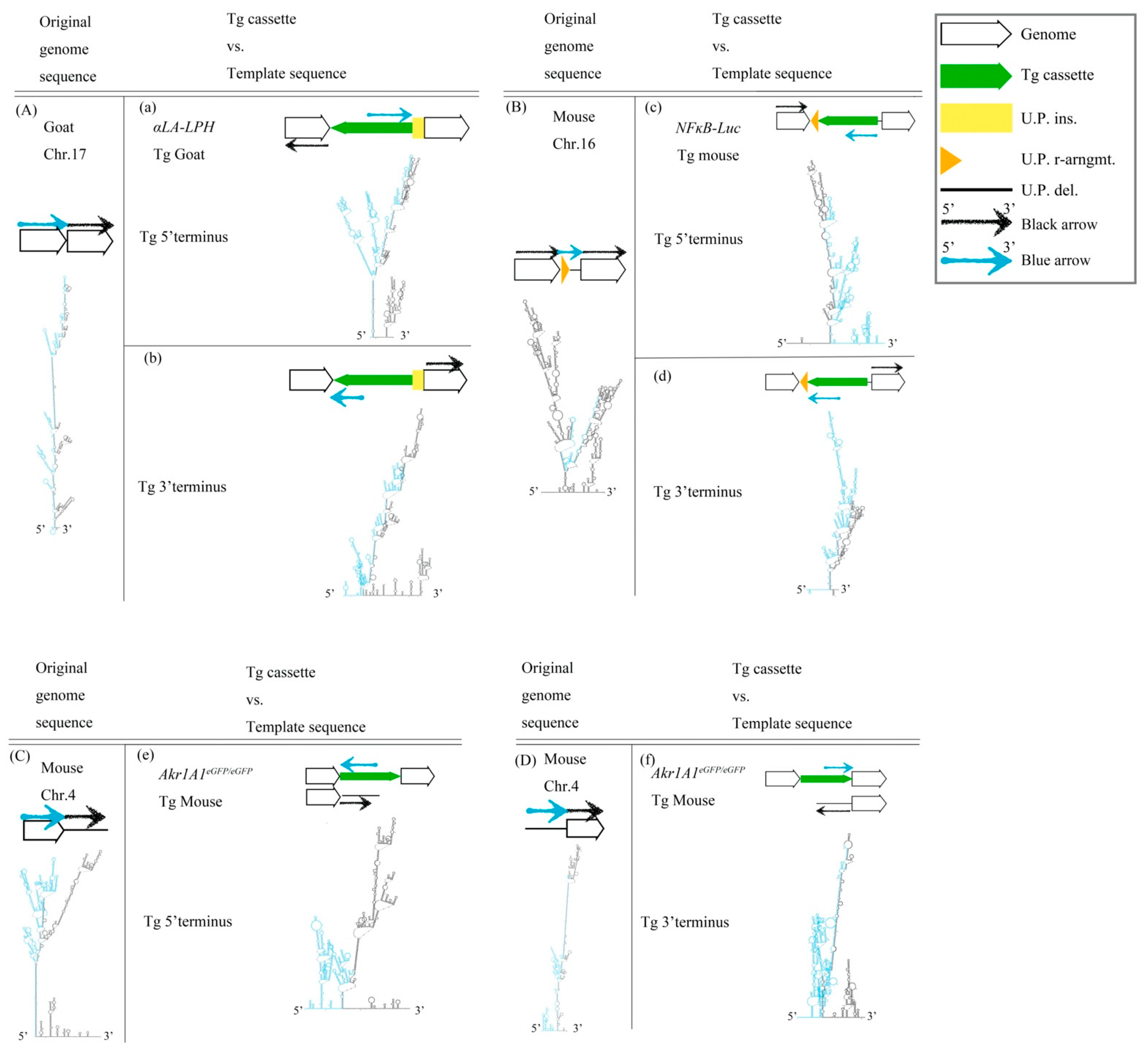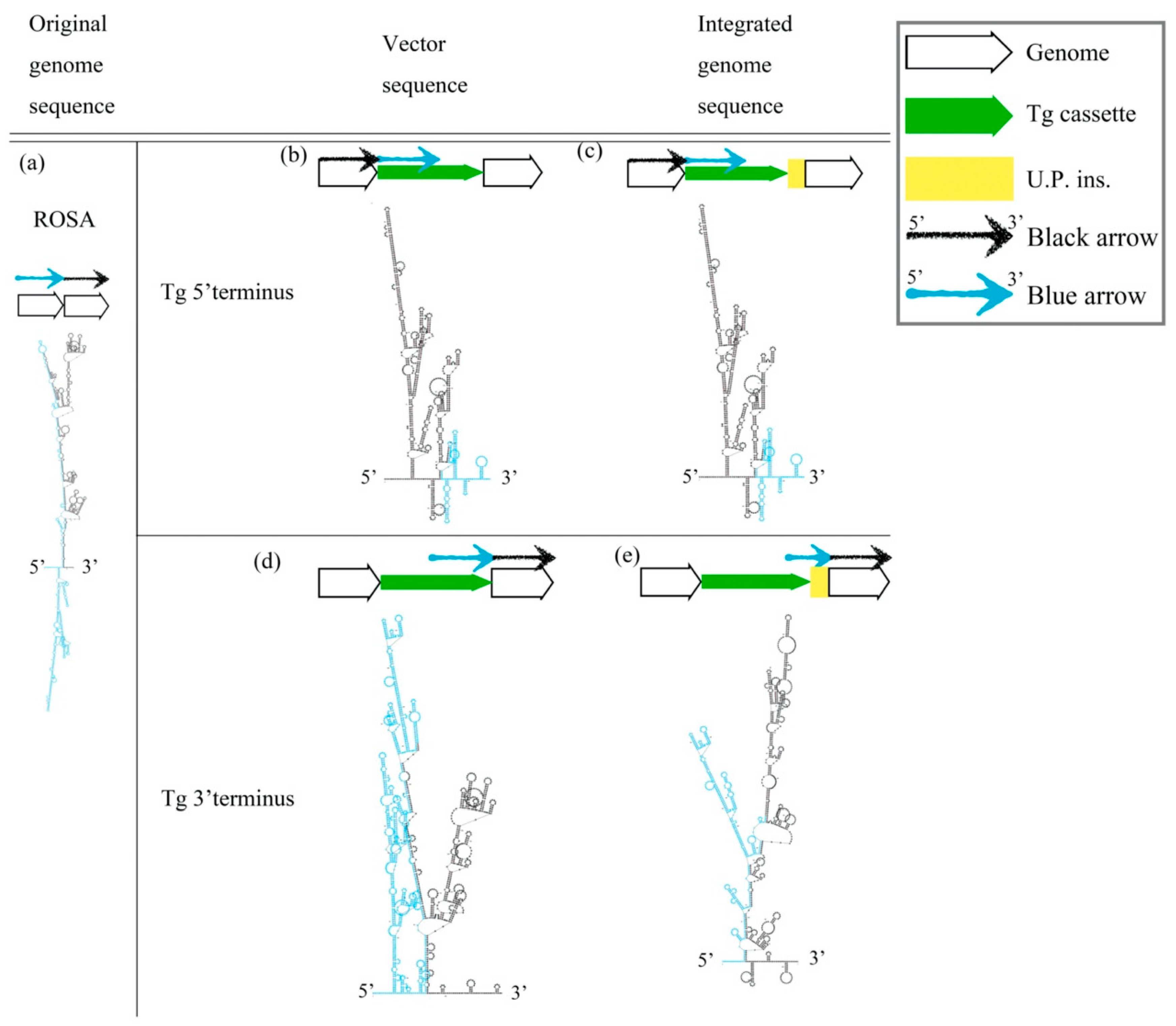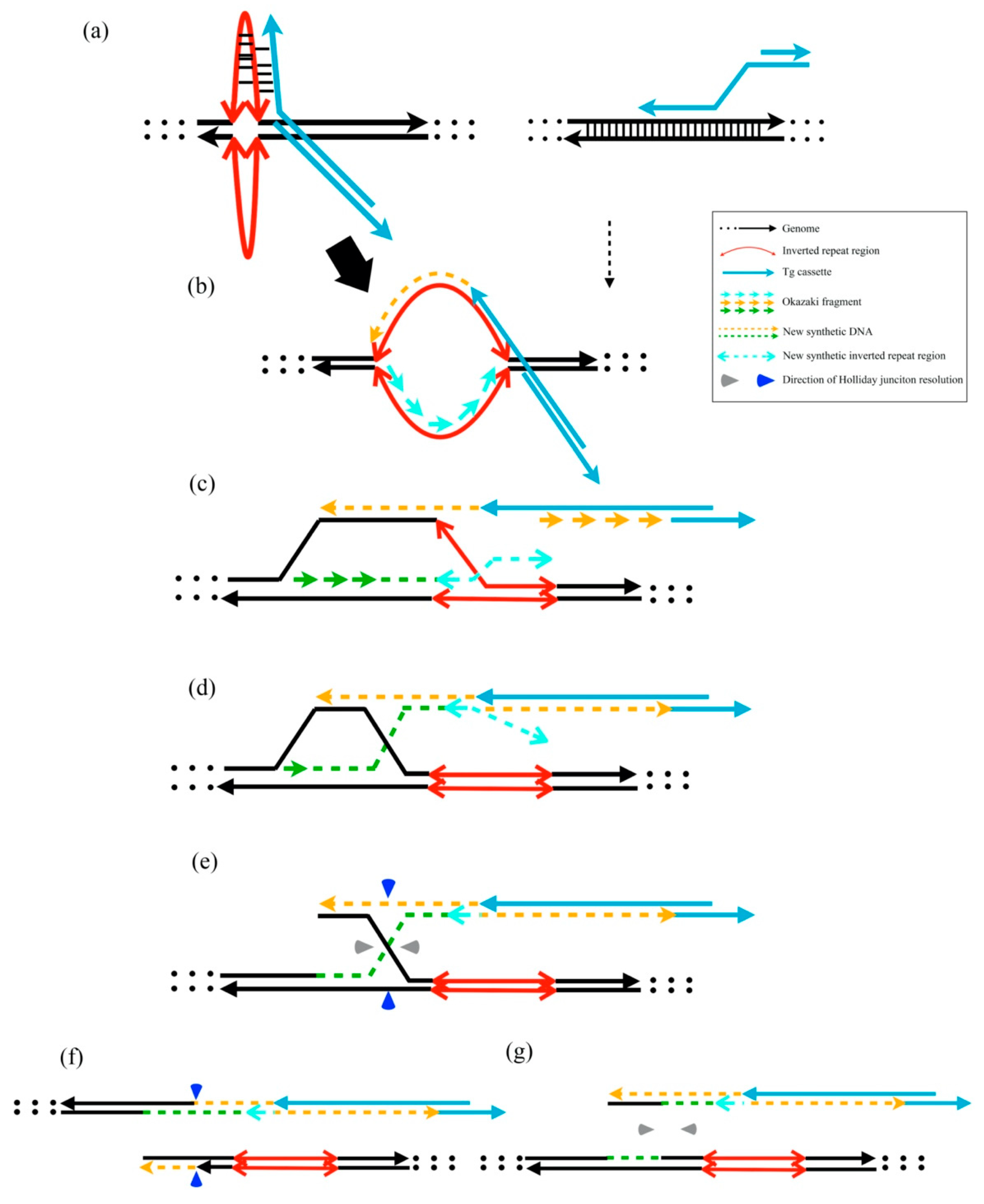Cruciform DNA Structures Act as Legible Templates for Accelerating Homologous Recombination in Transgenic Animals
Abstract
:1. Introduction
2. Results
2.1. Cruciform DNA Structures Are a Hotspot of HR in Transgenic Animal Genomes
2.2. Stability of the Secondary Structure May Relate with Sequence Modification after the HR Mechanism in the Gene-Edited Mouse Genome and αLA-LPH Tg Goat
2.3. The Cruciform DNA Structure in HA Improves KI Efficiency
2.4. Only the Presence of the Cruciform Structure in HA Improves the KI Efficiency
3. Discussion
| Factors | Summary | References |
|---|---|---|
| Repair Enzymes | ||
| Activation of HR pathway | Weak improvement of KI efficiency by HR enzyme overexpression or RS-1 addition (0~20%) | [50,51,52] |
| Inhibition of NHEJ pathway | Moderate improvement of KI efficiency by NHEJ inhibitors (0~40%) | [53,54,55] |
| Arrest of cell cycle | Strong improvement of KI efficiency by using small molecules to arrest cell cycle (20~40%) | [56,57] |
| DNA conformation | ||
| The distance between the template DNA and the host DNA | Strong improvement of KI efficiency by modifying donor DNA (20~40%) | [58] |
| The structure of the template DNA | Indirect evidence showed that the cruciform structure from ITR affected KI efficiency | [60,61] |
| Our data suggested that the cruciform structure improved KI efficiency (10~20%) | This study | |
| The transcription activity of the DSB allele | High level of transcription activity around DSB sites induced HR via Rad52 activation and 53BP1 inhibition | [62,63,64] |
| DNA:RNA hybrid forms are related to DNA repair mechanisms at DSB loci | [65,66] |
4. Materials and Methods
4.1. Transgenic Animal Production
4.2. Analysis of Transgenic Cassettes in the Integration Sites of Chromosomes
4.2.1. αLA-LPH Tg Goats
4.2.2. Akr1a1eGFP/eGFP Tg Mice
4.2.3. NFκB-Luc Tg Mice
4.2.4. Gt(ROSA)26Sorem(αLA-AP1x6)BM2/M Tg Mice
4.3. Secondary Structure Prediction
4.4. Construction of Knock-In Reporter Plasmids
4.5. Cell Culture and Transfection
4.6. Quantitation of Knock-In Rates
4.7. Statistical Analysis
5. Conclusions
Supplementary Materials
Author Contributions
Funding
Institutional Review Board Statement
Informed Consent Statement
Data Availability Statement
Acknowledgments
Conflicts of Interest
References
- Bikard, D.; Loot, C.; Baharoglu, Z.; Mazel, D. Folded DNA in action: Hairpin formation and biological functions in prokaryotes. Microbiol. Mol. Biol. Rev. 2010, 74, 570–588. [Google Scholar] [CrossRef] [PubMed] [Green Version]
- Lilley, D.M. The kinetic properties of cruciform extrusion are determined by DNA base-sequence. Nucleic Acids Res. 1985, 13, 1443–1465. [Google Scholar] [CrossRef] [PubMed] [Green Version]
- Ramreddy, T.; Sachidanandam, R.; Strick, T.R. Real-time detection of cruciform extrusion by single-molecule DNA nanomanipulation. Nucleic Acids Res. 2011, 39, 4275–4283. [Google Scholar] [CrossRef] [PubMed] [Green Version]
- Pearson, C.E.; Zorbas, H.; Price, G.B.; Zannis-Hadjopoulos, M. Inverted repeats, stem-loops, and cruciforms: Significance for initiation of DNA replication. J. Cell. Biochem. 1996, 63, 1–22. [Google Scholar] [CrossRef]
- Zannis-Hadjopoulos, M.; Yahyaoui, W.; Callejo, M. 14-3-3 cruciform-binding proteins as regulators of eukaryotic DNA replication. Trends Biochem. Sci. 2008, 33, 44–50. [Google Scholar] [CrossRef]
- Dutra, B.E.; Lovett, S.T. Cis and trans-acting effects on a mutational hotspot involving a replication template switch. J. Mol. Biol. 2006, 356, 300–311. [Google Scholar] [CrossRef]
- Jamil, M.A.; Sharma, A.; Nuesgen, N.; Pezeshkpoor, B.; Heimbach, A.; Pavlova, A.; Oldenburg, J.; El-Maarri, O. F8 inversions at Xq28 causing hemophilia A are associated with specific methylation changes: Implication for molecular epigenetic diagnosis. Front. Genet. 2019, 10, 508. [Google Scholar] [CrossRef]
- Margaglione, M.; Castaman, G.; Morfini, M.; Rocino, A.; Santagostino, E.; Tagariello, G.; Tagliaferri, A.R.; Zanon, E.; Bicocchi, M.P.; Castaldo, G.; et al. The Italian AICE-Genetics hemophilia A database: Results and correlation with clinical phenotype. Haematologica 2008, 93, 722–728. [Google Scholar] [CrossRef] [Green Version]
- Lyu, C.; Xue, F.; Liu, X.; Liu, W.; Fu, R.; Sun, T.; Wu, R.; Zhang, L.; Li, H.; Zhang, D.; et al. Identification of mutations in the F8 and F9 gene in families with haemophilia using targeted high-throughput sequencing. Haemophilia 2016, 22, e427–e434. [Google Scholar] [CrossRef]
- Beri, S.; Bonaglia, M.C.; Giorda, R. Low-copy repeats at the human VIPR2 gene predispose to recurrent and nonrecurrent rearrangements. Eur. J. Hum. Genet. 2013, 21, 757–761. [Google Scholar] [CrossRef] [Green Version]
- Gimelli, G.; Pujana, M.A.; Patricelli, M.G.; Russo, S.; Giardino, D.; Larizza, L.; Cheung, J.; Armengol, L.; Schinzel, A.; Estivill, X.; et al. Genomic inversions of human chromosome 15q11–q13 in mothers of Angelman syndrome patients with class II (BP2/3) deletions. Hum. Mol. Genet. 2003, 12, 849–858. [Google Scholar] [CrossRef] [PubMed] [Green Version]
- Young, S.M., Jr.; Samulski, R.J. Adeno-associated virus (AAV) site-specific recombination does not require a Rep-dependent origin of replication within the AAV terminal repeat. Proc. Natl. Acad. Sci. USA 2001, 98, 13525–13530. [Google Scholar] [CrossRef] [PubMed] [Green Version]
- Suzuki, Y.; Chew, M.L.; Suzuki, Y. Role of host-encoded proteins in restriction of retroviral integration. Front. Microbiol. 2012, 3, 227. [Google Scholar] [CrossRef] [PubMed] [Green Version]
- Wilson, M.H.; Coates, C.J.; George, A.L., Jr. PiggyBac transposon-mediated gene transfer in human cells. Mol. Ther. 2007, 15, 139–145. [Google Scholar] [CrossRef] [PubMed]
- Miller, D.G.; Petek, L.M.; Russell, D.W. Adeno-associated virus vectors integrate at chromosome breakage sites. Nat. Genet. 2004, 36, 767–773. [Google Scholar] [CrossRef] [PubMed] [Green Version]
- Hirsch, M.L. Adeno-associated virus inverted terminal repeats stimulate gene editing. Gene Ther. 2015, 22, 190–195. [Google Scholar] [CrossRef] [PubMed] [Green Version]
- Laible, G. Production of transgenic livestock: Overview of transgenic technologies. In Animal Biotechnology 2: Emerging Breeding Technologies; Niemann, H., Wrenzycki, C., Eds.; Springer International Publishing: Cham, Switzerland, 2018; pp. 95–121. [Google Scholar]
- Yoshimi, K.; Kunihiro, Y.; Kaneko, T.; Nagahora, H.; Voigt, B.; Mashimo, T. ssODN-mediated knock-in with CRISPR-Cas for large genomic regions in zygotes. Nat. Commun. 2016, 7, 10431. [Google Scholar] [CrossRef] [Green Version]
- Chen, F.; Pruett-Miller, S.M.; Huang, Y.; Gjoka, M.; Duda, K.; Taunton, J.; Collingwood, T.N.; Frodin, M.; Davis, G.D. High-frequency genome editing using ssDNA oligonucleotides with zinc-finger nucleases. Nat. Methods 2011, 8, 753–755. [Google Scholar] [CrossRef]
- Bedell, V.M.; Wang, Y.; Campbell, J.M.; Poshusta, T.L.; Starker, C.G.; Krug, R.G., 2nd; Tan, W.; Penheiter, S.G.; Ma, A.C.; Leung, A.Y.; et al. In vivo genome editing using a high-efficiency TALEN system. Nature 2012, 491, 114–118. [Google Scholar] [CrossRef] [Green Version]
- Meyer, M.; Ortiz, O.; Hrabe de Angelis, M.; Wurst, W.; Kuhn, R. Modeling disease mutations by gene targeting in one-cell mouse embryos. Proc. Natl. Acad. Sci. USA 2012, 109, 9354–9359. [Google Scholar] [CrossRef] [Green Version]
- Piazza, A.; Wright, W.D.; Heyer, W.D. Multi-invasions are recombination byproducts that induce chromosomal rearrangements. Cell 2017, 170, 760–773. [Google Scholar] [CrossRef] [PubMed]
- Leach, D.R. Long DNA palindromes, cruciform structures, genetic instability and secondary structure repair. Bioessays 1994, 16, 893–900. [Google Scholar] [CrossRef] [PubMed]
- Baker, E.S.; Dupuis, N.F.; Bowers, M.T. DNA hairpin, pseudoknot, and cruciform stability in a solvent-free environment. J. Phys. Chem. B 2009, 113, 1722–1727. [Google Scholar] [CrossRef] [PubMed]
- Alvarez, D.; Callejo, M.; Shoucri, R.; Boyer, L.; Price, G.B.; Zannis-Hadjopoulos, M. Analysis of the cruciform binding activity of recombinant 14-3-3zeta-MBP fusion protein, its heterodimerization profile with endogenous 14-3-3 isoforms, and effect on mammalian DNA replication in vitro. Biochemistry 2003, 42, 7205–7215. [Google Scholar] [CrossRef]
- Carballar, R.; Martinez-Lainez, J.M.; Samper, B.; Bru, S.; Ballega, E.; Mirallas, O.; Ricco, N.; Clotet, J.; Jimenez, J. CDK-mediated Yku80 phosphorylation regulates the balance between non-homologous end joining (NHEJ) and homologous directed recombination (HDR). J. Mol. Biol. 2020, 432, 166715. [Google Scholar] [CrossRef]
- Modesti, M.; Budzowska, M.; Baldeyron, C.; Demmers, J.A.; Ghirlando, R.; Kanaar, R. RAD51AP1 is a structure-specific DNA binding protein that stimulates joint molecule formation during RAD51-mediated homologous recombination. Mol. Cell 2007, 28, 468–481. [Google Scholar] [CrossRef] [Green Version]
- Pires, E.; Sharma, N.; Selemenakis, P.; Wu, B.; Huang, Y.; Alimbetov, D.S.; Zhao, W.; Wiese, C. RAD51AP1 mediates RAD51 activity through nucleosome interaction. J. Biol. Chem. 2021, 297, 100844. [Google Scholar] [CrossRef]
- Mazina, O.M.; Rossi, M.J.; Thomaa, N.H.; Mazin, A.V. Interactions of human rad54 protein with branched DNA molecules. J. Biol. Chem. 2007, 282, 21068–21080. [Google Scholar] [CrossRef] [Green Version]
- Alvarez, D.; Novac, O.; Callejo, M.; Ruiz, M.T.; Price, G.B.; Zannis-Hadjopoulos, M. 14-3-3sigma is a cruciform DNA binding protein and associates in vivo with origins of DNA replication. J. Cell. Biochem. 2002, 87, 194–207. [Google Scholar] [CrossRef]
- Chasovskikh, S.; Dimtchev, A.; Smulson, M.; Dritschilo, A. DNA transitions induced by binding of PARP-1 to cruciform structures in supercoiled plasmids. Cytom. Part A 2005, 68, 21–27. [Google Scholar] [CrossRef]
- Coufal, J.; Jagelska, E.B.; Liao, J.C.; Brazda, V. Preferential binding of p53 tumor suppressor to p21 promoter sites that contain inverted repeats capable of forming cruciform structure. Biochem. Biophys. Res. Commun. 2013, 441, 83–88. [Google Scholar] [CrossRef] [PubMed]
- Naseem, R.; Sturdy, A.; Finch, D.; Jowitt, T.; Webb, M. Mapping and conformational characterization of the DNA-binding region of the breast cancer susceptibility protein BRCA1. Biochem. J. 2006, 395, 529–535. [Google Scholar] [CrossRef] [PubMed] [Green Version]
- Holkers, M.; de Vries, A.A.; Goncalves, M.A. Nonspaced inverted DNA repeats are preferential targets for homology-directed gene repair in mammalian cells. Nucleic Acids Res. 2012, 40, 1984–1999. [Google Scholar] [CrossRef] [PubMed] [Green Version]
- Buck, T.M.; Wijnholds, J. Recombinant adeno-associated viral vectors (rAAV)-vector elements in ocular gene therapy clinical trials and transgene expression and bioactivity assays. Int. J. Mol. Sci. 2020, 21, 4197. [Google Scholar] [CrossRef]
- Penaud-Budloo, M.; Le Guiner, C.; Nowrouzi, A.; Toromanoff, A.; Cherel, Y.; Chenuaud, P.; Schmidt, M.; von Kalle, C.; Rolling, F.; Moullier, P.; et al. Adeno-associated virus vector genomes persist as episomal chromatin in primate muscle. J. Virol. 2008, 82, 7875–7885. [Google Scholar] [CrossRef] [Green Version]
- Duan, D.; Sharma, P.; Yang, J.; Yue, Y.; Dudus, L.; Zhang, Y.; Fisher, K.J.; Engelhardt, J.F. Circular intermediates of recombinant adeno-associated virus have defined structural characteristics responsible for long-term episomal persistence in muscle tissue. J. Virol. 1998, 72, 8568–8577. [Google Scholar] [CrossRef]
- Earley, L.F.; Conatser, L.M.; Lue, V.M.; Dobbins, A.L.; Li, C.; Hirsch, M.L.; Samulski, R.J. Adeno-associated virus serotype-specific inverted terminal repeat sequence role in vector transgene expression. Hum. Gene Ther. 2020, 31, 151–162. [Google Scholar] [CrossRef]
- Zhou, Q.; Tian, W.; Liu, C.; Lian, Z.; Dong, X.; Wu, X. Deletion of the B-B′ and C-C′ regions of inverted terminal repeats reduces rAAV productivity but increases transgene expression. Sci. Rep. 2017, 7, 5432. [Google Scholar] [CrossRef]
- Cataldi, M.P.; McCarty, D.M. Hairpin-end conformation of adeno-associated virus genome determines interactions with DNA-repair pathways. Gene Ther. 2013, 20, 686–693. [Google Scholar] [CrossRef] [Green Version]
- Lentz, T.B.; Samulski, R.J. Insight into the mechanism of inhibition of adeno-associated virus by the Mre11/Rad50/Nbs1 complex. J. Virol. 2015, 89, 181–194. [Google Scholar] [CrossRef] [Green Version]
- Lobachev, K.S.; Gordenin, D.A.; Resnick, M.A. The Mre11 complex is required for repair of hairpin-capped double-strand breaks and prevention of chromosome rearrangements. Cell 2002, 108, 183–193. [Google Scholar] [CrossRef] [Green Version]
- Urnov, F.D.; Rebar, E.J.; Holmes, M.C.; Zhang, H.S.; Gregory, P.D. Genome editing with engineered zinc finger nucleases. Nat. Rev. Genet. 2010, 11, 636–646. [Google Scholar] [CrossRef] [PubMed]
- Christian, M.; Cermak, T.; Doyle, E.L.; Schmidt, C.; Zhang, F.; Hummel, A.; Bogdanove, A.J.; Voytas, D.F. Targeting DNA double-strand breaks with TAL effector nucleases. Genetics 2010, 186, 757–761. [Google Scholar] [CrossRef] [PubMed] [Green Version]
- Jinek, M.; East, A.; Cheng, A.; Lin, S.; Ma, E.; Doudna, J. RNA-programmed genome editing in human cells. eLife 2013, 2, e00471. [Google Scholar] [CrossRef] [Green Version]
- Jachimowicz, R.D.; Goergens, J.; Reinhardt, H.C. DNA double-strand break repair pathway choice—From basic biology to clinical exploitation. Cell Cycle 2019, 18, 1423–1434. [Google Scholar] [CrossRef]
- Ingram, S.P.; Warmenhoven, J.W.; Henthorn, N.T.; Smith, E.A.K.; Chadwick, A.L.; Burnet, N.G.; Mackay, R.I.; Kirkby, N.F.; Kirkby, K.J.; Merchant, M.J. Mechanistic modelling supports entwined rather than exclusively competitive DNA double-strand break repair pathway. Sci. Rep. 2019, 9, 6359. [Google Scholar] [CrossRef]
- Shen, W.; Ma, Y.; Qi, H.; Wang, W.; He, J.; Xiao, F.; Zhu, H.; He, S. Kinetics model of DNA double-strand break repair in eukaryotes. DNA Repair 2021, 100, 103035. [Google Scholar] [CrossRef]
- Cristea, S.; Freyvert, Y.; Santiago, Y.; Holmes, M.C.; Urnov, F.D.; Gregory, P.D.; Cost, G.J. In vivo cleavage of transgene donors promotes nuclease-mediated targeted integration. Biotechnol. Bioeng. 2013, 110, 871–880. [Google Scholar] [CrossRef]
- Tran, N.-T.; Bashir, S.; Li, X.; Rossius, J.; Chu, V.T.; Rajewsky, K.; Kühn, R. Enhancement of precise gene editing by the association of Cas9 with homologous recombination factors. Front. Genet. 2019, 10, 365. [Google Scholar] [CrossRef] [Green Version]
- Song, J.; Yang, D.; Xu, J.; Zhu, T.; Chen, Y.E.; Zhang, J. RS-1 enhances CRISPR/Cas9- and TALEN-mediated knock-in efficiency. Nat. Commun. 2016, 7, 10548. [Google Scholar] [CrossRef] [Green Version]
- Kurihara, T.; Kouyama-Suzuki, E.; Satoga, M.; Li, X.; Badawi, M.; Baig, D.N.; Yanagawa, T.; Uemura, T.; Mori, T.; Tabuchi, K. DNA repair protein RAD51 enhances the CRISPR/Cas9-mediated knock-in efficiency in brain neurons. Biochem. Biophys. Res. Commun. 2020, 524, 621–628. [Google Scholar] [CrossRef] [PubMed]
- Maruyama, T.; Dougan, S.K.; Truttmann, M.C.; Bilate, A.M.; Ingram, J.R.; Ploegh, H.L. Increasing the efficiency of precise genome editing with CRISPR-Cas9 by inhibition of nonhomologous end joining. Nat. Biotechnol. 2015, 33, 538–542. [Google Scholar] [CrossRef] [PubMed]
- Hu, Z.; Shi, Z.; Guo, X.; Jiang, B.; Wang, G.; Luo, D.; Chen, Y.; Zhu, Y.-S. Ligase IV inhibitor SCR7 enhances gene editing directed by CRISPR-Cas9 and ssODN in human cancer cells. Cell Biosci. 2018, 8, 12. [Google Scholar] [CrossRef] [PubMed] [Green Version]
- Jayavaradhan, R.; Pillis, D.M.; Goodman, M.; Zhang, F.; Zhang, Y.; Andreassen, P.R.; Malik, P. CRISPR-Cas9 fusion to dominant-negative 53BP1 enhances HDR and inhibits NHEJ specifically at Cas9 target sites. Nat. Commun. 2019, 10, 2866. [Google Scholar] [CrossRef] [Green Version]
- Wienert, B.; Nguyen, D.N.; Guenther, A.; Feng, S.J.; Locke, M.N.; Wyman, S.K.; Shin, J.; Kazane, K.R.; Gregory, G.L.; Carter, M.A.M.; et al. Timed inhibition of CDC7 increases CRISPR-Cas9 mediated templated repair. Nat. Commun. 2020, 11, 2109. [Google Scholar] [CrossRef]
- Lin, S.; Staahl, B.T.; Alla, R.K.; Doudna, J.A. Enhanced homology-directed human genome engineering by controlled timing of CRISPR/Cas9 delivery. eLife 2014, 3, e04766. [Google Scholar] [CrossRef]
- Gu, B.; Posfai, E.; Rossant, J. Efficient generation of targeted large insertions by microinjection into two-cell-stage mouse embryos. Nat. Biotechnol. 2018, 36, 632–637. [Google Scholar] [CrossRef]
- Ranawakage, D.C.; Okada, K.; Sugio, K.; Kawaguchi, Y.; Kuninobu-Bonkohara, Y.; Takada, T.; Kamachi, Y. Efficient CRISPR-Cas9-mediated knock-in of composite tags in Zebrafish using long ssDNA as a donor. Front. Cell. Dev. Biol. 2020, 8, 598634. [Google Scholar] [CrossRef]
- Mizuno, N.; Mizutani, E.; Sato, H.; Kasai, M.; Ogawa, A.; Suchy, F.; Yamaguchi, T.; Nakauchi, H. Intra-embryo gene cassette knockin by CRISPR/Cas9-mediated genome editing with adeno-associated viral vector. iScience 2018, 9, 286–297. [Google Scholar] [CrossRef] [Green Version]
- Chen, S.; Sun, S.; Moonen, D.; Lee, C.; Lee, A.Y.; Schaffer, D.V.; He, L. CRISPR-READI: Efficient generation of knockin mice by CRISPR RNP electroporation and AAV donor infection. Cell Rep. 2019, 27, 3780–3789.e4. [Google Scholar] [CrossRef] [Green Version]
- Yasuhara, T.; Kato, R.; Hagiwara, Y.; Shiotani, B.; Yamauchi, M.; Nakada, S.; Shibata, A.; Miyagawa, K. Human Rad52 promotes XPG-mediated R-loop processing to initiate transcription-associated homologous recombination repair. Cell 2018, 175, 558–570.e11. [Google Scholar] [CrossRef] [PubMed] [Green Version]
- Xue, C.; Greene, E.C. New roles for RAD52 in DNA repair. Cell Res. 2018, 28, 1127–1128. [Google Scholar] [CrossRef] [PubMed]
- Li, G.; Wang, H.; Zhang, X.; Wu, Z.; Yang, H. A Cas9-transcription factor fusion protein enhances homology-directed repair efficiency. J. Biol. Chem. 2021, 296, 100525. [Google Scholar] [CrossRef] [PubMed]
- Lafuente-Barquero, J.; Garcia-Rubio, M.L.; Martin-Alonso, M.S.; Gomez-Gonzalez, B.; Aguilera, A. Harmful DNA:RNA hybrids are formed in cis and in a Rad51-independent manner. eLife 2020, 9, e56674. [Google Scholar] [CrossRef] [PubMed]
- Bader, A.S.; Hawley, B.R.; Wilczynska, A.; Bushell, M. The roles of RNA in DNA double-strand break repair. Br. J. Cancer 2020, 122, 613–623. [Google Scholar] [CrossRef] [Green Version]
- Lai, C.W.; Chen, H.L.; Tsai, T.C.; Chu, T.W.; Yang, S.H.; Chong, K.Y.; Chen, C.M. Sexually dimorphic expression of eGFP transgene in the Akr1A1 locus of mouse liver regulated by sex hormone-related epigenetic remodeling. Sci. Rep. 2016, 6, 24023. [Google Scholar] [CrossRef] [Green Version]
- Yen, C.C.; Chang, W.H.; Tung, M.C.; Chen, H.L.; Liu, H.C.; Liao, C.H.; Lan, Y.W.; Chong, K.Y.; Yang, S.H.; Chen, C.M. Lactoferrin protects hyperoxia-induced lung and kidney systemic inflammation in an in vivo imaging model of NF-kappaB/luciferase transgenic mice. Mol. Imaging Biol. 2020, 22, 526–538. [Google Scholar] [CrossRef]
- Zuker, M. Mfold web server for nucleic acid folding and hybridization prediction. Nucleic Acids Res. 2003, 31, 3406–3415. [Google Scholar] [CrossRef]
- Fischer, K.B.; Hannah, C.K.; Edward, C.M. Sources of off-target expression from recombinase-dependent AAV vectors and mitigation with cross-over insensitive ATG-out vectors. Proc. Natl. Acad. Sci. USA 2019, 116, 27001–27010. [Google Scholar] [CrossRef]





Publisher’s Note: MDPI stays neutral with regard to jurisdictional claims in published maps and institutional affiliations. |
© 2022 by the authors. Licensee MDPI, Basel, Switzerland. This article is an open access article distributed under the terms and conditions of the Creative Commons Attribution (CC BY) license (https://creativecommons.org/licenses/by/4.0/).
Share and Cite
Ou-Yang, H.; Yang, S.-H.; Chen, W.; Yang, S.-H.; Cidem, A.; Sung, L.-Y.; Chen, C.-M. Cruciform DNA Structures Act as Legible Templates for Accelerating Homologous Recombination in Transgenic Animals. Int. J. Mol. Sci. 2022, 23, 3973. https://doi.org/10.3390/ijms23073973
Ou-Yang H, Yang S-H, Chen W, Yang S-H, Cidem A, Sung L-Y, Chen C-M. Cruciform DNA Structures Act as Legible Templates for Accelerating Homologous Recombination in Transgenic Animals. International Journal of Molecular Sciences. 2022; 23(7):3973. https://doi.org/10.3390/ijms23073973
Chicago/Turabian StyleOu-Yang, Huan, Shiao-Hsuan Yang, Wei Chen, Shang-Hsun Yang, Abdulkadir Cidem, Li-Ying Sung, and Chuan-Mu Chen. 2022. "Cruciform DNA Structures Act as Legible Templates for Accelerating Homologous Recombination in Transgenic Animals" International Journal of Molecular Sciences 23, no. 7: 3973. https://doi.org/10.3390/ijms23073973
APA StyleOu-Yang, H., Yang, S.-H., Chen, W., Yang, S.-H., Cidem, A., Sung, L.-Y., & Chen, C.-M. (2022). Cruciform DNA Structures Act as Legible Templates for Accelerating Homologous Recombination in Transgenic Animals. International Journal of Molecular Sciences, 23(7), 3973. https://doi.org/10.3390/ijms23073973









